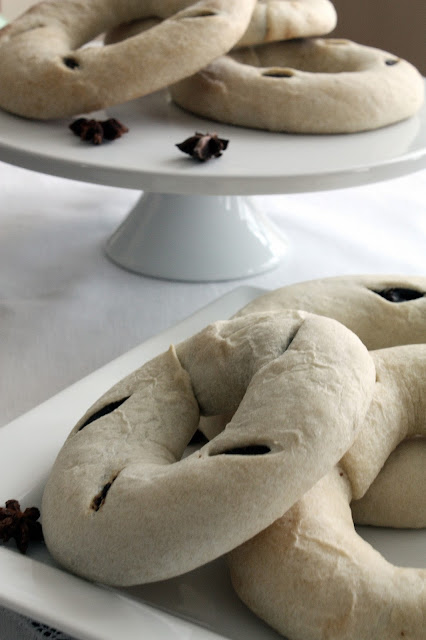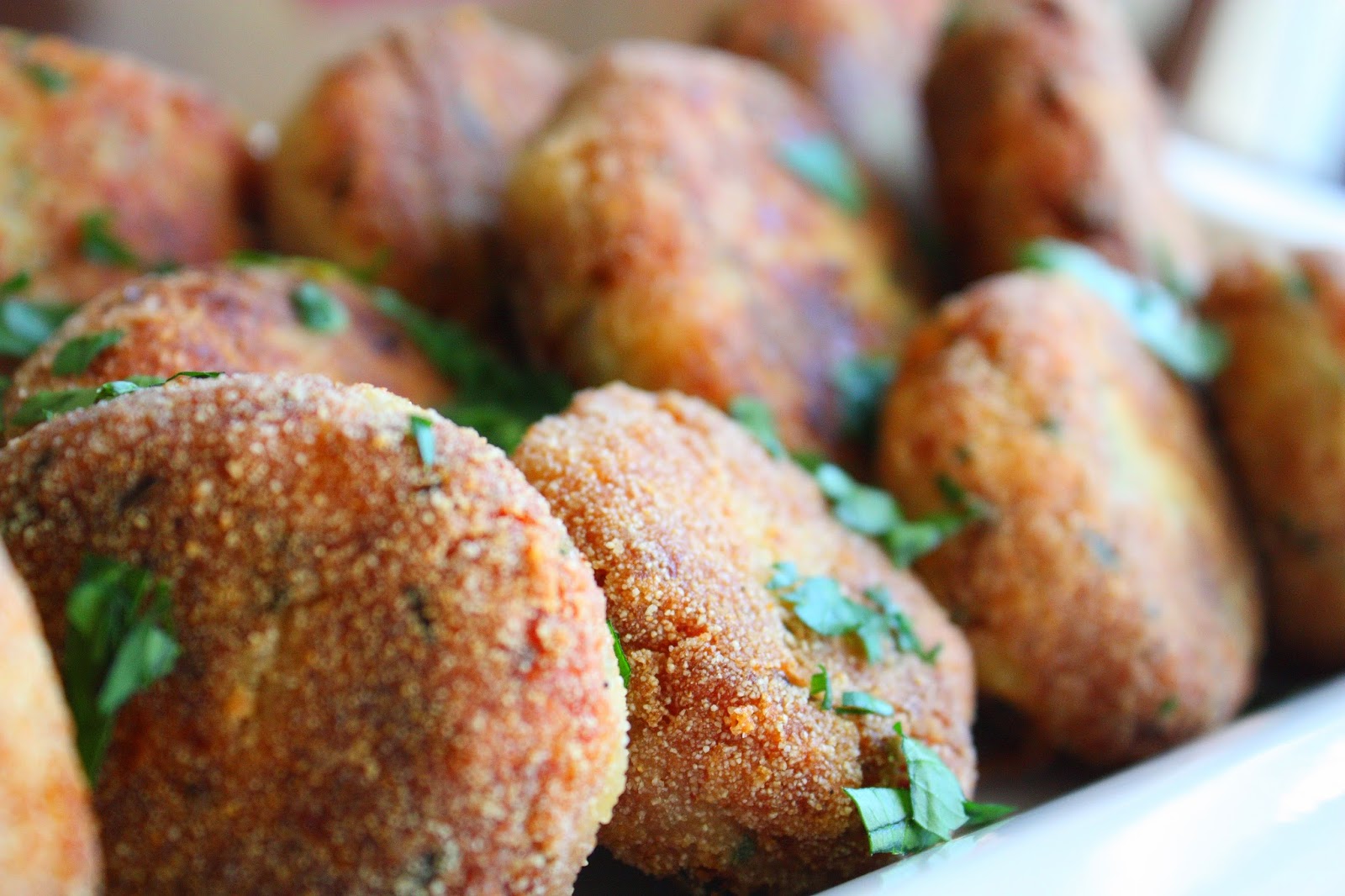Qagħaq Ta'l-Għasel (Molasses Rings)
Qagħaq Ta'l-Għasel literally translates to "honey rings," but you won't find any honey in these molasses-stuffed pastries. Although traditionally made around Christmastime in Malta, these sweet anise-flavored rings can be enjoyed any time of year.
When I first started to research Qagħaq Ta'l-Għasel, "treacle" kept popping up in many of the recipes, which led to a new research project... From what I've learned treacle is British and definitely interchangeable with blackstrap molasses, but I was curious if they were interchangeable because they were so similar or because they were the exact same product with different names.
Unfortunately, the results of my research were not definitive. Some sources claim that the only real difference between "treacle" and "molasses" is what side of the Atlantic it's sold on. Other sources claim there is a difference in the extraction process. Best I can tell, both molasses and black treacle are by-products from refining sugar. As the sugarcane is processed, the syrup that is drained off is what we Americans call molasses. The first and second drainings produce relatively sweet syrups, but the third draining has a much lower sugar content and is also high in vitamins and minerals since the syrup is so concentrated. This third draining is called blackstrap molasses in the States, and I'm pretty sure that it is also what the Brits call dark or black treacle.
After all that, I went ahead and got the black treacle because I found its tin so charming. By all means though, get blackstrap molasses if it is more readily available to you.
We had a few family recipes to pull from for this treat. My mom recommended using Nanna's pastry dough recipe and my Uncle Paul's filling recipe since she hadn't had much luck when trying to recreate Nanna's filling.
I ended up doing a mash up between the Nanna's filling and Uncle Paul's filling, using the spice blend Nanna called for, but more thickeners like Uncle Paul.
I employed the good ol' trial and error method I'm fond of when recreating these family recipes in order to figure how best to join the ring together. I hope the collage above helps any of you wanting to venture into Qagħaq Ta'l-Għasel baking for the first time. This method works, but if anyone knows a better one, please let me know!
All in all, I was pretty happy with the results, especially considering it was my first time making them. I think the rings will turn out even prettier in the future now that I have a practiced hand.
So, if you're looking for an impressive pastry to serve as the centerpiece of your dessert table and you like the licorice-like flavor of anisette, consider baking this Maltese classic. You won't be disappointed.
-----------------------------------------------------------------------------------
Qagħaq Ta'l-Għasel (Molasses Rings)
Adapted from Nanna and Uncle Paul
This recipe requires the pastry dough and the filling to rest in the fridge for several hours. I've found it's easiest to make the pastry and the filling on one day and then form the rings and bake them off the next. It will take an hour to prep the first day and then an hour and a half the next day to assemble and bake.
Yield: 9 six-inch rings
Total Time: 14.5 hours; Active Prep Time: 2.5 hours; Bake Time: 25-30 minutes (each batch)
For the pastry:
22.5 ounces (5 cups) all purpose flour
3 ounces (1/2 cup) semolina flour
3.5 ounces (1/2 cup) sugar
1/2 teaspoon salt
1 stick (1/2 cup) butter, cold
1/2 cup Crisco, cold
10 ounces (1 1/4 cup) water
For the filling:
12 ounces (1 cup plus 2 tablespoons) blackstrap molasses or dark treacle
12 ounces (1 1/2 cups) water
6 ounces (3/4 cup) granulated sugar
5 ounces (2/3 cup) brown sugar
1 1/2 tablespoons anisette liquor, or 1 1/2 teaspoons anise extract, or 1 tablespoon ground star anise/anise seed
1/4 teaspoon cloves
1/4 teaspoon allspice
1/4 teaspoon salt
Zest of 1/2 an orange
Zest of one lemon
16 ounces (2 3/4 cups) semolina flour
1.125 ounces (1/4 cup) all purpose flour
Make the pastry dough:
Whisk together flour, semolina, sugar, and salt in a medium bowl. Using a pastry cutter, two butter knives, or your finger tips, quickly work the butter and Crisco into the flour mixture until it resembles course meal with some oat-sized flakes. Stir in water, taking care to not overwork the dough; it will be quite shaggy and a little dry at this point. Turn out on a floured board and gently knead a few times to incorporate all the flour. Form the dough into a disc, cover with plastic wrap, and refrigerate for at least two hours so it can hydrate and rest.
Make the filling:
Whisk together flour, semolina, sugar, and salt in a medium bowl. Using a pastry cutter, two butter knives, or your finger tips, quickly work the butter and Crisco into the flour mixture until it resembles course meal with some oat-sized flakes. Stir in water, taking care to not overwork the dough; it will be quite shaggy and a little dry at this point. Turn out on a floured board and gently knead a few times to incorporate all the flour. Form the dough into a disc, cover with plastic wrap, and refrigerate for at least two hours so it can hydrate and rest.
Make the filling:
Combine molasses, water, sugars, anisette, cloves, allspice, salt, and zest in a large heavy-bottomed saucepan and gently bring to a boil over medium-high heat. Meanwhile, whisk together semolina and flour; gradually add to boiling molasses mixture, stirring constantly. Adjust heat to medium-low and simmer, stirring at all times, until mixture thickens, about 5 minutes. Remove from heat and allow to cool. Once completely cool, cover with plastic wrap, pressing it directly onto the filling, and refrigerate for at least 12 hours, or overnight.
To assemble:
Preheat oven to 350 degrees Fahrenheit. Divide pastry dough into three equal portions. [Work with one portion at a time, following all directions below from start to finish before beginning to work with the next portion. As the first batch bakes, you can begin to work with the next portion of dough, and so on. Keep dough covered until ready to use.]
Gently roll one portion of the dough into a rectangle approximately 14-15 inches by 9-10 inches. Divide into three long skinny rectangles, approximately approximately 14-15 inches by 3 inches. Trim any ends that are uneven.
Divide the cooled molasses filling into nine equal portions. Scoop a portion of the filling onto the middle of each of the rectangles, leaving about an inch on each of the long sides. The filling should go all the way to one skinny end, but have a half inch gap on the other. Gently pull the pastry up and over the filling from one side, and then carefully roll it over the other side to form a long snake. Smooth the pastry log with your fingers before coiling it into a ring. Place the end that has filling up to the edge onto the overhang of pastry from the other end and tuck the extra pastry around, so that no filling is exposed. Gently pinch the seams to seal and set with a moistened finger. Repeat with remaining two rectangles of dough.
Carefully place the pastry rings seam-side down on a lightly floured baking sheet. Every 2 inches or so, cut small decorative slits into the dough, using a very sharp knife. Bake for 25-30 minutes or until the pastry dough has barely colored and the exposed filling looks set.
Gently roll one portion of the dough into a rectangle approximately 14-15 inches by 9-10 inches. Divide into three long skinny rectangles, approximately approximately 14-15 inches by 3 inches. Trim any ends that are uneven.
Divide the cooled molasses filling into nine equal portions. Scoop a portion of the filling onto the middle of each of the rectangles, leaving about an inch on each of the long sides. The filling should go all the way to one skinny end, but have a half inch gap on the other. Gently pull the pastry up and over the filling from one side, and then carefully roll it over the other side to form a long snake. Smooth the pastry log with your fingers before coiling it into a ring. Place the end that has filling up to the edge onto the overhang of pastry from the other end and tuck the extra pastry around, so that no filling is exposed. Gently pinch the seams to seal and set with a moistened finger. Repeat with remaining two rectangles of dough.
Carefully place the pastry rings seam-side down on a lightly floured baking sheet. Every 2 inches or so, cut small decorative slits into the dough, using a very sharp knife. Bake for 25-30 minutes or until the pastry dough has barely colored and the exposed filling looks set.
Meanwhile, as the first batch bakes, repeat the process with the next portion of dough, and then the next.
Notes:
-Nanna used to pipe the filling onto the pastry rectangles to ensure a smooth ring.
-To help get the pastry to split open nicely and expose the filling, help push the filling up through the slit before baking.
-These will last a week or two, but they freeze beautifully if you need a longer storage solution.










Love the contrast of the serving ware and pastry exterior to the dark molasses. And I agree that the treacle tin has a charming tin!
ReplyDeleteThanks Thao! In my research I read that part of the visual appeal you want to create with qagħaq ta'l-għasel is the striking contrast between the almost white pastry and the dark filling. :)
Delete